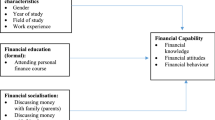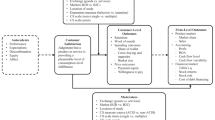Abstract
As consumer requirements for financial services permeate society, they link various financial institutions more closely together, developing divergent financial products. This research develops a conceptual framework for discussing consumer money attitudes, financial literacy regarding financial decisions, and financial behavior. Study findings suggest that consumers who have retention-planning and achievement-esteem attitudes toward money make high-risk financial decisions; anxiety toward money tends to exist mainly in low-risk investors. Financial literacy affects consumer financial behaviors, and demographic variables play segmentation roles. Theoretical contributions and management implications are provided in the study for related research, education departments and financial firms.

Similar content being viewed by others
References
Baker PM, Hagedorn RB (2008) Attitudes to money in a random sample of adults: factor analysis of the MAS and MBBS scales, and correlations with demographic variables. J Socio-Econ 37(5):1803–1814
Beverly SG, Burkhalter EK (2005) Improving the financial literacy and practices of youth. Child Sch 27(2):121–124
Bollen NP, Whaley RE (2009) Hedge fund risk dynamics: implications for performance appraisal. J Finance 64:985–1035
Chang RY, Hanna S (1992) Consumer credit search behavior. Int J Consum Stud 16(1):207–227
Chang SJ, van Witteloostuijn A, Eden L (2010) From the editors: common method variance in international business research. J Int Bus Stud 41(2):178–184
Chen H, Volpe RP (1998) An analysis of personal financial literacy among college student. Financial Serv Rev 7:107–128
Chiu RK, Luk V, Tang TLP (2002) Retaining and motivating employees: compensation preferences in Hong Kong and China. Pers Rev 31(4):402–431
Collins JM (2013) The impacts of mandatory financial education: evidence from a randomized field study. J Econ Behav Organ. doi:10.1016-j.jebo.2012.08.011
Csiszar EN (2007) An update on use of modern financial instruments in the insurance sector. Geneva Pap Risk Insur Issue Pract 32:319–331
Dowling NA, Corney T, Hoiles L (2009) Financial management practices and money attitudes as determinants of financial problems and dissatisfaction in young male Australian workers. J Financial Couns Plan 20:5–13
Esenvalde I (2010) Psychological predictors of savings behavior: contrasting the impact of optimism and burnout on self-control, achievement motivation and savings behavior. Alliant International University, Marshall Goldsmith School of Management, Los Angeles
Fox J, Bartholomae S, Lee J (2005) Building the case for financial education. J Consum Aff 39:195–214
Furnham A (1984) Many sides of the coin: the psychology of money usage. Pers Individ Differ 5(5):501–509
Furnham A, Wilson E, Telford K (2012) The meaning of money: the validation of a short money-types measure. Pers Individ Differ 52(6):707–711
Gambetti E, Giusberti F (2012) The effect of anger and anxiety traits on investment decisions. J Econ Psychol 13(6):1059–1069
Goldberg H, Lewis RT (1978) Money madness: the psychology of saving spending, loving and hating money. William Morrow and Company, Inc, New York
Goldsmith EB, Goldsmith RE (1997) Gender differences in perceived and real knowledge of financial investments. Psychol Rep 80:36–58
Goldsmith RE, Goldsmith EB (2006) The effect of investment education on gender difference in financial knowledge. J Pers Finance 5:55–68
Haiyang C, Ronald PV (1998) An analysis of personal financial literacy among college student. Financ Serv Rev 7(2):107–128
Hanley A, Wilhelm MS (1992) Compulsive buying: an exploration into self-esteem and money attitude. J Econ Psychol 13:5–18
Hayhoe CR, Leach L, Turner PR (1999) Discriminating the number of credit cards held by college students using credit and money attitudes. J Econ Psychol 20:643–656
Hilgert MA, Hogarth JH, Beverly SG (2003) Household financial management: the connection between knowledge and behavior. Fed Reserv Bull 89:309–322
Hogarth M, Hilgert M (2002) Financial knowledge, experience and learning preferences: preliminary results form a new survey on financial literacy. Consum Interest Annu 48:1–7
Huddleston CA, Danes SM (1999) Impact evaluation of a financial literacy program: evidence for needed educational policy changes. Consum Interest Annu 45:109–115
Hung AA, Parker AM, Yoong JK (2009) Defining and measuring financial literacy. RAND Labor Popul WR708:1–28
Izquierdo RJS, Vicedo JC (2012) Corporate social responsibility of financial organizations in the social economy: a case study on savings banks. Serv Bus 6(1):99–115
Keller C, Siegrist M (2006a) Money attitude typology and stock investment. J Behav Finance 7:88–96
Keller C, Siegrist M (2006b) Investing in stocks: the influence of financial risk attitude and values-related money and stock market attitudes. J Econ Psychol 27:285–303
Krueger DW (1986) Money, success, and success phobia. In: Krueger DW (ed) The last taboo: money as symbol and reality in psychotherapy and psychoanalysis. Brunner-Mazel, New York, pp 3–16
Lim VKG, Teo TSH, Loo GL (2003) Sex, financial hardship and locus of control: an empirical study of attitudes towards money among Singaporean Chinese. Pers Individ Differ 34(3):411–429
Lin CH, Yang HL, Liou DY (2009) The impact of corporate social responsibility on financial performance: evidence from business in Taiwan. Technol Soc 31(1):56–63
Mandell L (2005) The connection between saving financial literacy. National Credit Union Youth Week, April 2005, 17–23
Maslow AH (1943) A theory of human motivation. Psychol Rev 50:370
Masuo DM, Malroutu L, Hanashiro R, Kim JH (2004) College students’ money beliefs and behaviors: an Asian perspective: emerging trends and issues among Asian consumers and families. J Fam Econ Issues 25:469–481
Medina JF, Saegert J, Gresham A (1996) Comparison of Mexican-American and Anglo-American attitudes toward money. J Consum Aff 30(1):124–128
Meier S, Sprenger C (2007) Impatience and credit behavior: evidence from a field experiment. Federal Reserve Bank, Boston
Mishkin FS (2001) The economics of money, banking, and financial markets. Basic Books, New York
Omar OE (2008) Determinants of retail bank choice in Nigeria: a focus on gender-based choice decisions. Serv Bus 2(3):249–265
Perry VG (2008) Is ignorance bill? Consumer accuracy in judgments about credit ratings. J Consum Aff 42:189–204
Perry VG, Morris MD (2005) Who is in control? The role of self-perception, knowledge, and income in explaining consumer financial behavior. J Consum Aff 39:299–313
Podsakoff PM, Organ DW (1986) Self-reports in organizational research: problems and prospects. J Manag 12(4):531–544
Podsakoff PM, MacKenzie SB, Lee JY, Podsakoff NP (2003) Common method biases in behavioral research: a critical review of the literature and recommended remedies. J Appl Psychol 88:879–903
Sebstad J, Cohen M, Stack K (2005) Assessing the outcomes of financial education. 2005 Micronfinance Opportunities, Citigroup Foundation, Washington, DC
Shih TY, Wickramasekera R (2011) Export decisions within Taiwanese electrical and electronic SMEs: the role of management characteristics and attitudes. Asia Pac J Manag 28(2):353–377
Singhapakdi A, Vitell SJ, Lee DJ, Nisius AM, Yu GB (2012) The influence of love of money and religiosity on ethical decision-making in marketing. J Bus Ethics. doi:10.1007-s10551-012-1334-2
Stone B, Maury RV (2006) Indicators of personal financial debt using a multi-disciplinary behavioral model. J Econ Psychol 27:543–556
Tang TLP (1992) The meaning money revisited. J Organ Behav 13:197–202
Van Rooij M, Lusardi A, Alessie R (2011) Financial literacy and stock market participation. J Financial Econ 101(2):449–472
Vitell SJ, Singh JJ, Paolillo JGP (2007) Consumers’ ethical beliefs: the roles of money, religiosity and attitude toward business. J Bus Ethics 73:369–379
Volpe RP, Chen H, Pavlicko JJ (1996) Personal investment literacy among college students: a survey. Financ Pra Edu 6:86–94
Wood R, Zaichkowsky JL (2004) Attitudes and trading behavior of stock market investors: a segmentation approach. J Behav Finance 5:170–179
Yamauchi KT, Templer DI (1982) The development of a money attitude scale. J Pers Assess 46:522–528
Author information
Authors and Affiliations
Corresponding author
Appendix: Question items development concerning financial literacy (See Chen and Volpe (1998); Goldsmith and Goldsmith (2006); Perry (2008), compiled by the authors)
Appendix: Question items development concerning financial literacy (See Chen and Volpe (1998); Goldsmith and Goldsmith (2006); Perry (2008), compiled by the authors)
-
1.
Which of the following has the lowest risk? A. bond; B. stock; C. deferral.
-
2.
Interest earned on savings accounts is tax-free. A. correct; B. not correct; C. not above of all.
-
3.
If interest rates decrease, the price of a Treasury bond will A. decrease; B. increase; C. uncertain.
-
4.
Investing $1000 a year for 10 years will earn the same amount of money as investing $2000 a year for 5 years if the interest rate is the same for both investments. A. correct; B. not correct; C. the same.
-
5.
People will be financially better off if the cost of living increases by more than their income. A. correct; B. not correct; C. unknown.
-
6.
It is financially worthwhile to borrow money for investment if the interest rate on the loan is less than the expected return. A. correct; B. not correct; C. unknown.
-
7.
The cheapest way to use a credit card is to pay off the bill in full each month. A. correct; B. not correct; C. unknown.
-
8.
Over the long run, people can expect to earn more money by investing in stocks than by putting money into U.S. savings bonds. A. correct; B. not correct; C. unknown.
-
9.
What will be the impact on the interest rate people pay on a loan if they:
A. always eventually pay off their debts, but are sometimes late on monthly bills? B. get someone else to co-sign the loan with them? C. have never borrowed money before? D. offer the lender some collateral for the loan?
-
10.
What will be the impact on a person’s credit rating if he-she:
A. charges lots of money on several credit cards, and makes the minimum payment each month?
B. has a good payment record and applies for many new credit cards? C. skips a student loan payment?
D. never borrows money or uses a credit card for anything? E. misses a couple of loan payments but makes them up, with the interest, the following month? F. has a legal judgment over a disputed bill?
-
11.
The main reason to purchase insurance is to:
A. protect you from a loss recently incurred. B. provide you with excellent investment returns.
C. protect you from experiencing a catastrophic loss. D. protect you from small incidental losses.
E. improve your standard of living by filing fraudulent claims.
-
12.
Which statement is false?
A. You can use your credit card to receive a cash advance. B. If your credit card balance is $1000 and you pay $300, interest is charged on the unpaid balance of $700. C. The rate of interest on your credit card is normally higher than you can earn on a certificate of deposit. D. A credit card company will not charge you interest if you pay off the entire balance by the due date. E. You cannot spend more than your line of credit.
Rights and permissions
About this article
Cite this article
Shih, TY., Ke, SC. Determinates of financial behavior: insights into consumer money attitudes and financial literacy. Serv Bus 8, 217–238 (2014). https://doi.org/10.1007/s11628-013-0194-x
Received:
Accepted:
Published:
Issue Date:
DOI: https://doi.org/10.1007/s11628-013-0194-x




